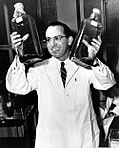University of Pittsburgh
Expression error: Unexpected < operator.Expression error: Unexpected < operator.
 | |
Former names | Pittsburgh Academy (1787–1819) Western University of Pennsylvania (1819–1908) |
|---|---|
| Motto | Veritas et Virtus (Latin) |
Motto in English | Truth and Virtue |
| Type | State-related research university |
| Established | February 28, 1787 |
| Endowment | $4.311 billion (2019)[1] |
| Chancellor | Patrick D. Gallagher |
| Provost | Ann E. Cudd |
Academic staff | 5,240[a] |
| Students | 28,391[b] |
| Undergraduates | 19,200 |
| Postgraduates | 9,191 |
| Location | , , United States |
| Campus | Urban, 132 acres (53 ha) |
| Colors | Pitt Royal and Pitt Gold[2] [3] |
| Athletics | NCAA Division I – ACC, EAGL |
| Affiliations | AAU, APLU, EDUCAUSE, MSA, ORAU, URA |
| Mascot | Roc the Panther |
| Website | www |
Invalid designation | |
| Designated | November 2, 1979[4] |
The University of Pittsburgh is a public university in the city of Pittsburgh in the United States of America. It is also called "Pitt". Pitt was started in 1787.[5] Pitt has 27,562 students. Pitt is famous for philosophy,[6][7] studying other countries,[8] and its hospital called the "University of Pittsburgh Medical Center" (UPMC).[9][10] Pitt does a lot of research.[11] Pitt is also famous for its tall building named the "Cathedral of Learning".[12] Pitt is also famous for sports. Pitt's best sports are American football and basketball.[13]
Pictures
| Wikimedia Commons has media related to Lua error in Module:Commons_link at line 62: attempt to index field 'wikibase' (a nil value).. |
Pitt's art building named "Frick Fine Arts Building"
Pitt student apartments
Pitt basketball game
University Of Pittsburgh Media
Hugh Henry Brackenridge, founder of Pittsburgh Academy, the precursor to the University of Pittsburgh
The Cathedral of Learning, the centerpiece of Pitt's campus and the tallest educational building in the Western Hemisphere
Jonas Salk developed the first polio vaccine at the University of Pittsburgh.
The restored Louis XV mirrored ballroom of the Beaux-Arts styled William Pitt Union
The art gallery at the Frick Fine Arts Building
Thomas Starzl Biomedical Science Tower is connected to the med school and UPMC's flagship hospitals
Aerial view of the university and Oakland neighborhood; Carnegie Mellon University is at top-right
References
- ↑ As of June 30, 2019. "U.S. and Canadian Institutions Listed by Fiscal Year (FY) 2019 Endowment Market Value and Change in Endowment Market Value from FY 2018 to FY 2019". National Association of College and University Business Officers and TIAA. Retrieved January 31, 2020.
- ↑ Borghetti, E.J.; Sepich, R.J.; Welsh, Celeste, eds. (2019). "Pitt Quick Facts: University Info". University of Pittsburgh Brand Guidelines (PDF). University of Pittsburgh Althetic Communications Office. p. 42. Archived from the original (PDF) on February 6, 2020. Retrieved October 23, 2019.
Colors: Pitt Royal and Pitt Gold
- ↑ "Primary Palette". University of Pittsburgh Office of University Communications. 2019. Archived from the original on 9 October 2019. Retrieved 1 September 2019.
- ↑ "PHMC Historical Markers Search". Pennsylvania Historical and Museum Commission. Commonwealth of Pennsylvania. Archived from the original (Searchable database) on March 21, 2016. Retrieved January 25, 2014.
- ↑ Alberts, Robert C. (1987). Pitt: The Story of the University of Pittsburgh 1787–1987. University of Pittsburgh Press. book One, p. 1. ISBN 0-8229-1150-7. Archived from the original on 2010-06-18. Retrieved 2009-04-29.
- ↑ "The Philosophical Gourmet Report". March 2009. Archived from the original on 2006-11-15. Retrieved 2009-04-29.
- ↑ "NRC Rankings in Each of 41 Areas". Research-Doctorate Programs in the United States: Continuity and Change. National Research Council. 1995. Archived from the original on 2021-01-25. Retrieved 2009-01-02.
- ↑ Gill, Cindy (Fall 2007). ""The Company We Keep"". Pitt. University of Pittsburgh. Archived from the original on 2008-01-14. Retrieved 2008-04-29.
- ↑ "Best Graduate Schools: Medical: University of Pittsburgh". USNews.com. 2008. Archived from the original on 2008-12-19. Retrieved 2009-01-02.
- ↑ UMPC Media Relations (2008-07-11). "UPMC Named to U.S. News & World Report Honor Roll of America's Best Hospitals for the Ninth Time". Press release. Archived from the original on 2009-02-04. https://web.archive.org/web/20090204073516/http://www.upmc.com/MediaRelations/NewsReleases/2008/Pages/US-News-08.aspx. Retrieved 2009-03-14.
- ↑ "University Times". 2006-09-14. Archived from the original on 2011-09-08. Retrieved 2007-10-31.
- ↑ "PENNSYLVANIA — Allegheny County". National Register of Historic Places. Retrieved 2008-04-28.
- ↑ O'Brien, Jim, ed. (1982). Hail to Pitt: A Sports History of the University of Pittsburgh. Wolfson Publishing Co. ISBN 0-916114-08-2.
Notes
- ↑ This figure reflects the total number of faculty at the Pittsburgh campus only. 373 additional faculty serve the four regional campuses for a university-wide total of 5,613 faculty members.
- ↑ This enrollment figure reflects the total headcount of full-time and part-time undergraduate and graduate students attending classes at the University of Pittsburgh-Pittsburgh Campus in Fall 2019 only. An additional 5,353 full-time and part-time undergraduate students attend the university across the four regional campuses for a university-wide headcount of 33,744 total students, 24,553 of which are undergraduates.
















